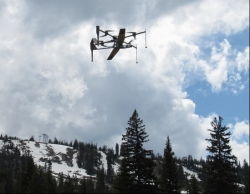FLARES 2.0 Demonstrates High DA Power Margin
Flight test data indicates that Hood Tech’s Flying Launch and Recovery System (FLARES 2.0) multicopter used only 58% throttle at 9600ft density altitude. “FLARES achieves robustness by using generously-sized components, and redundancy,” states Hood Tech President, Dr. Andy von Flotow. “UAVs that carry their VTOL-stuff for the entire mission invariably skimp on VTOL component sizing, sacrificing redundancy, power margin and high/hot capability.”

Anthony Lakes, OR, June 19, 2019 --(PR.com)-- Flight test data indicate that Hood Tech’s Flying Launch and Recovery System (FLARES 2.0) multicopter used only 58% throttle at 9600 ft. density altitude.
The photo shows the FLARES 2.0 Multicopter carrying an 85 lb. aircraft above the Anthony Lakes Ski Resort in June 2019 (7,100 ft. elevation, 65F, 9,600 ft. density altitude.)
“FLARES achieves robustness by using generously-sized components, and redundancy,” states Hood Tech President, Dr. Andy von Flotow. “UAVs that carry their VTOL-stuff for the entire mission invariably skimp on VTOL component sizing, sacrificing redundancy, power margin and high/hot capability.”
In February 2019 FLARES was upgraded to FLARES 2.0. To date, FLARES 2.0 configuration has a perfect record through 50 flights.
FLARES 2.0 is now ready to provide VTOL to any fixed-wing aircraft up to 100 pounds at sea level, and up to 85 pounds at 8,000 ft. DA.
The photo shows the FLARES 2.0 Multicopter carrying an 85 lb. aircraft above the Anthony Lakes Ski Resort in June 2019 (7,100 ft. elevation, 65F, 9,600 ft. density altitude.)
“FLARES achieves robustness by using generously-sized components, and redundancy,” states Hood Tech President, Dr. Andy von Flotow. “UAVs that carry their VTOL-stuff for the entire mission invariably skimp on VTOL component sizing, sacrificing redundancy, power margin and high/hot capability.”
In February 2019 FLARES was upgraded to FLARES 2.0. To date, FLARES 2.0 configuration has a perfect record through 50 flights.
FLARES 2.0 is now ready to provide VTOL to any fixed-wing aircraft up to 100 pounds at sea level, and up to 85 pounds at 8,000 ft. DA.
Contact
Hood Tech Corp., Vision Inc.
Cory Roeseler
541-387-2255
hoodtechvision.com
Cory Roeseler
541-387-2255
hoodtechvision.com
Categories
